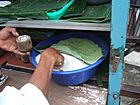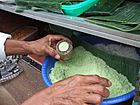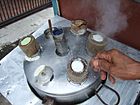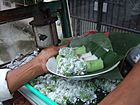Kue putu facts for kids

Kue Putu, filled with palm sugar and served with desiccated coconut.
|
|
| Alternative names | Putu bambu, putu bumbung |
|---|---|
| Type | Sweet dumpling |
| Course | Dessert, Snack |
| Place of origin | Indonesia |
| Region or state | East Java |
| Serving temperature | Room temperature |
| Main ingredients | Rice flour, palm sugar, coconut |
| Similar dishes | Puttu, puto, puto bumbóng, kueh tutu, mache |
Kue putu or putu bambu is a yummy sweet snack from Indonesia. It's a type of kue, which is an Indonesian word for traditional cakes or snacks. This treat is made from rice flour and gets its green color from pandan leaves.
Inside, you'll find sweet palm sugar. The special part is how it's cooked: it's steamed inside bamboo tubes! That's why it's sometimes called putu bambu (bamboo putu). After steaming, it's served with grated coconut. You can often find kue putu sold by street vendors and in traditional markets, especially in Java, Indonesia.
Contents
How is Kue Putu Made?
Making kue putu is a fun process! First, rice flour is mixed with green pandan leaf coloring. This gives the snack its unique green look. Then, a sweet filling of ground palm sugar is added.
Next, this mix is carefully placed into special bamboo tubes. These tubes are then put into a steamer. Hot steam cooks the cakes inside the bamboo. Once cooked, the warm cakes are gently pushed out of the tubes. Finally, they are topped with fresh grated coconut and are ready to eat!
What Does "Putu Bumbung" Mean?
The name putu bambu comes from the Javanese word bumbung. This word means "bamboo" or "a hollow tube." So, putu bambu literally means "bamboo putu." This name makes sense because the snack is steamed inside bamboo tubes!
Different Shapes and Fillings
While kue putu is famous for its bamboo tube shape, there are other versions too. In Malaysia, Kerala, and Sri Lanka, you might find a flatter, disc-shaped version called putu piring. Piring means "plate" in Malay.
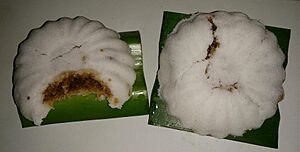
In Indonesia, a thicker, more round version is called putu mangkok. Mangkok means "bowl" in Indonesian. In Singapore, this same round snack is known as kueh tutu.
Traditionally, kue putu is filled with palm sugar. But today, some new kinds have different fillings. You might find them with chocolate or even abon (which is a type of beef floss).
Similar Snacks Around the World
Did you know there are similar steamed rice cakes in other countries?
In the Philippines, there's a general name for steamed rice cakes called puto. One type, puto bumbóng, is very much like kue putu. It's also cooked in bamboo tubes! However, puto bumbóng doesn't use pandan leaves. It's often made with a special purple glutinous rice called pirurutong, which gives it a deep purple color.
In India (especially in Kerala, Tamil Nadu, and Karnataka) and Sri Lanka, there's a similar dish called puttu or pittu. It's also a steamed rice cake, showing how popular these types of snacks are across different cultures!


